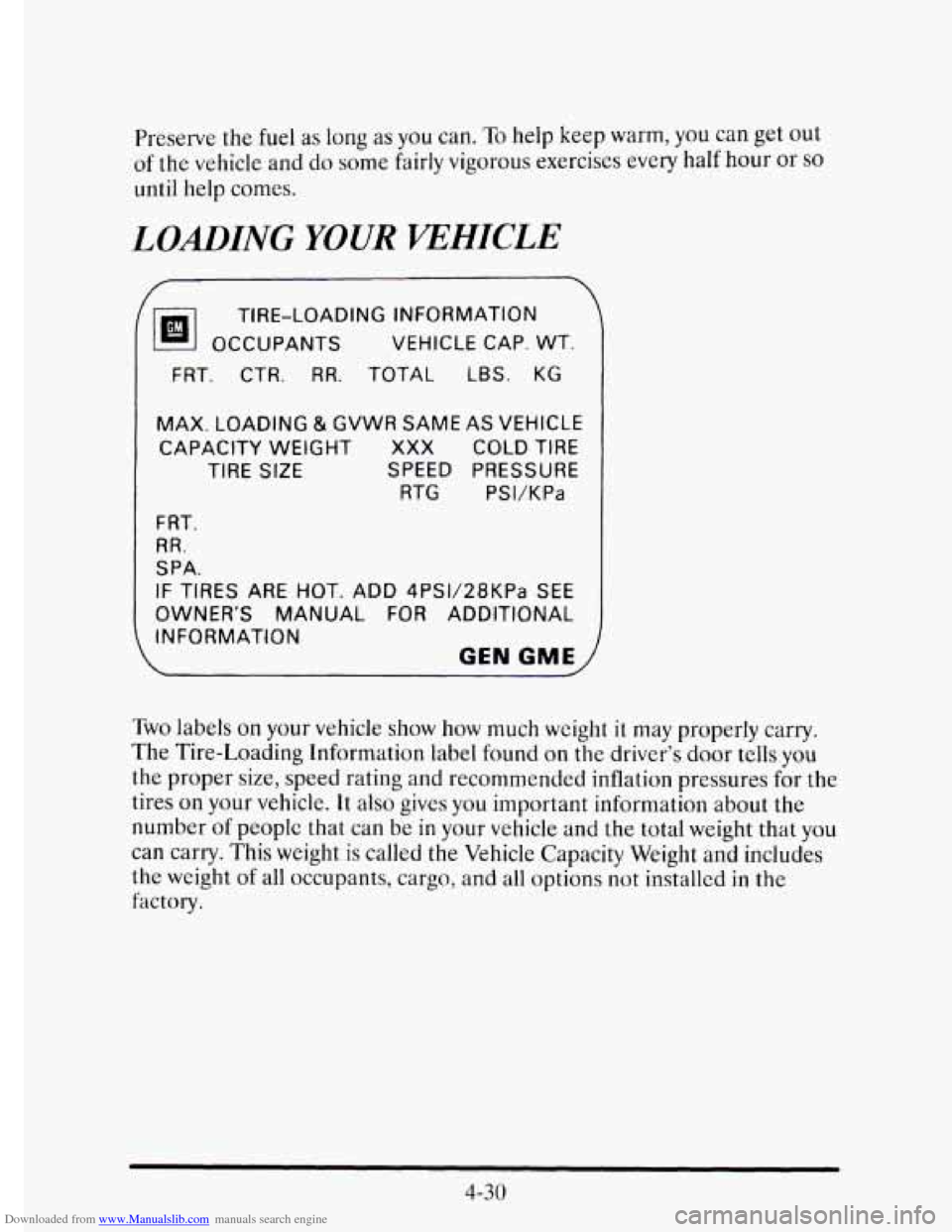Page 216 of 395
Downloaded from www.Manualslib.com manuals search engine I
You can run the
engine to keep warm,
but be careful.
Run your engine only as long as
you must. This saves fuel. When you run
the engine, make it go a little faster than just idle. That is, push the
accelerator slightly. This uses less fuel for the heat that you get and it
keeps the battery charged. You
will need a well-charged battery to restart
the vehicle, and possibly
for signaling later on with your headlamps. Let
the heater run
for awhile.
Then, shut the engine off and close the window almost all the way to
preserve the heat. Start the engine again and repeat this only when you
feel really uncomfortable from the cold. But
do it as little as possible.
4-29
Page 217 of 395

Downloaded from www.Manualslib.com manuals search engine Preserve the fuel as long as you can. To help keep warm, you can get out
of the vehicle and do some fairly vigorous exercises every half hour or
SO
until help comes.
LOmING YOUR VEHICLE
~~
( TIRE-LOADING INFORMATION
OCCUPANTS VEHICLE CAP.
WT.
FRT. CTR. RR. TOTAL LBS. KG
MAX. LOADING
& GVWR SAME AS VEHICLE
CAPACITY WEIGHT XXX
COLD TIRE
TIRE SIZE SPEED PRESSURE
RTG PSVKPa
F
RT.
RR.
SPA.
IF TIRES ARE HOT. ADD 4PSV28KPa SEE
OWNER’S MANUAL FOR ADDITIONAL
INFORMATION
-_ - - - GEN GME,
Two labels on your vehicle show how much weight it may properly carry.
The Tire-Loading Information label found
on the driver’s door tells you
the proper size, speed rating and recommended inflation pressures for the
tires
on your vehicle. It also gives you important information about the
number
of peoplc that can be in your vehicle and the total weight that you
can carry. This weight
is called the Vehicle Capacity Weight and includes
the weight
of all occupants, cargo, and all options not installed in the
factory.
4-30
Page 324 of 395

Downloaded from www.Manualslib.com manuals search engine [Engine Compartment Fuse Block
~~~
E DISTR
USAGE I
INJ
IGN 1
FUEL PUMP
PCM (BAT) RTD (BAT)
F
A/C COMP
HDLPS
TURN/HAZ
DRL
DRL
HTD W/S
IGN OFF
L HDLP
LO
I R HDLP LO Ignition
Control Module
I
L HDLP HI
R HDLP HI
I
I
TRANSECS Sensing
& Diagnostic Module
Powertrain Control Module (PCM); PASS-KeymII Decode llodule
1,4,6 and 7 Fuel Injectors
2,3,5 and 8 Fuel Injectors
A/C Refrigerant Pressure Switch; Transaxle Range Switch;
Stop/BTSI/Cruise Brake Switch; Instrument Panel Cluster; Keyless
Entry Module; DiagnosticEnergy Reserve Module (Derm);
Cornering Lamps; Tbrn/Hazard Switch Assy; Chime Module;
Headlamp Switch; Twilight Sentinel/DRL Module
Fuel Pump; Oil Pressure Switch; Powertrain Control Module
Powertrain Control Module (PCM)
Road Sensing Suspension (RSS) Module
NC Compressor Clutch
Headlamp Dimmer Switch; Headlamp Relay “D” (Engine Comp.
Micro Relay Center); DRL Headlamp Relay
“E’ (with Daytime
Running Lamps); Powers C13
Stop/BTSI/Cruise Switch; Sto lamp Switch Capacitor; Anti-Slip
Regulation (ASR)S Traction 8ontrol
Hazard Flasher; Turn Flasher Relay; Turn Flasher Module
Daytime Running Lamps (Canada)
Left and Right Lo-Beam Headlamp (Canada)
Heated Windshield Control Module
Instrument Panel Cluster
Left Lo-Beam Headlamu
(PCM)
Right Lo-Beam Headlamp
Left Hi-Beam Headlamp
Right Hi-Beam Headlamp
Rear Defogger Relay; Electronic Level Control (ELC); Heated
Windshield; Heater and A/C Programmer; Cruise Control
Extended Travel Brake Switch; Powertrain Control Module (PCM); \
Cooling Fan Relays
1,2 and 3; Front and Rear Heated Oxygen Sensor
Power Steering Pressure Switch; Exhaust Gas Recirculation (EGR)
Valve; Transaxle Shift Solenoids A
& B; Evaporative Emission
Control Solenoid; Powertrain Control Module (PCM); Torque
Converter Clutch Solenoid; TCC Brake Switch
6-65